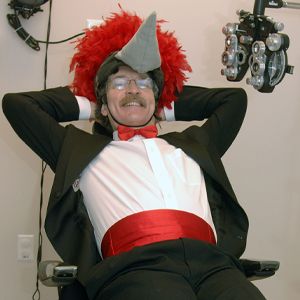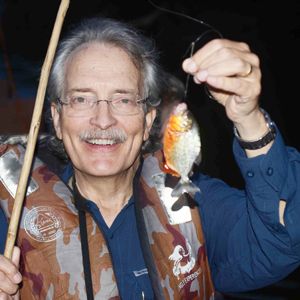Dr. Ivan Schwab is a professor of ophthalmology at the University of California Davis School of Medicine. He has been the director of corneal services at UC Davis Medical Center. In addition to remarkable clinical and teaching credentials, he is known for the development of a bioengineered artificial corneal surface.
What makes Dr. Schwab most remarkable, might be his broad thinking on vision, ophthalmology, and evolution. I have heard him lecture on these subjects as well as on rare double rainbows. He sees more colors than most. He has reported on comparative ophthalmology, described the visual systems of mysid shrimp and of sharks, and his book, “Evolution's Witness: How Eyes Evolved,” is a gem. It was named as a Notable Book of the Year by Scientific American. Dr. Schwab’s many awards include the Ig Nobel Prize in 2006 for why woodpeckers don’t get headaches.

Dr. Schwab dressed for the Ig Nobel Prize.
Dr. Sadun: Ivan, thanks for this opportunity. This is going to be another in a series of interviews with colorful luminaries in ophthalmology that has several purposes. I’ll be particularly interested in creating a sense of the world of ophthalmology, particularly academic ophthalmology, when you began your career. Young ophthalmologists, especially residents and fellows, are likely to be surprised to learn how different things were “back then.”
Can you start us off with comments about your early life?
Dr. Schwab: I was born and raised in Kingwood, a small coal mining town in the northern part of West Virginia. Loving parents and a rural childhood molded my early life and, in retrospect, it was as good as anyone could want. My mother was curious and always asked questions and read to me or for herself. My father was industrious and owned a pharmacy in this town of about 2000. I had to make my own distractions. I became interested in sports and in the animals around me as any kid in a rural setting would have done.
Dr. Sadun: Do you have an interesting childhood experience/story.
Dr. Schwab: I was expected to work in the family pharmacy when I wasn’t in school. There, I learned about medicine when serving customers, without a knowledge of the underlying science of their medical conditions. There was a rather large man with large hands and acromegaly who used to buy snuff; there was a very disheveled man redolent of garlic for half a block, who was self-treating for some unknown illness; there was the woman with thyroid eye disease with proptosis and markedly red eyes that was so startling, one could not look away; the rural farmer with Dupuytren's contracture that he attributed to a rattlesnake bite; and of course, the “blackfaced” miners who had spent way too long underground. I knew these people by name and wondered just what I was seeing. Eventually, I would discover how these people suffered
Dr. Sadun: So, your medical education began early and with an insight on the patient perspective. What was your next step in becoming a doctor?
Dr. Schwab: My mother further encouraged this interest with her questions about all things biologic. And both my older brothers headed for medicine as career choices. I grew up in a household steeped in biology and curiosity. Then I attended West Virginia University in Morgantown and majored in biology intending on medicine as a career.
Dr. Sadun: Interesting stories in college?
Dr. Schwab: Comparative osteology was difficult because the instructor would give spontaneous “pop” tests. This would raise a certain level of fear in all of us as we had no idea until we walked into class. One morning, we walked into a test that showed several bones and identifying characteristics which we had studied. But there were also bones that were not studied in class. I recognized the chicken bones because of a key bone—the furcula known to you as the wishbone--indicating this creature had been a bird. Growing up in a rural area, I knew the anatomy of chickens.
Dr. Sadun: You stayed on at West Virginia for medical school?
Dr. Schwab: Yes, though I spent the last six months at UCSF. I was raised near West Virginia University (WVU) Medical School. Northern West Virginia had a vibrant sheep industry with a woolen mill. My first grand rounds experience stunned me. By this time in school, I was especially interested in infectious and hereditary diseases. The patient was escorted into the large room and had a black eshcar on her forearm. Eventually, the infectious disease consultant gave the diagnosis of her cutaneous rash as anthrax (Woolsorter’s disease). In another grand rounds, a father gave a history of mood swings, hallucinations, weight loss, anemia, hypoglycemia and pancreatitis. Several members of the extended family had similar problems. There was a history of consanguinity. Eventually, the endocrinologist came up with the diagnosis of “maple sugar urine disease.” So, I assumed that these two diseases were rather common, but I have never seen a case of either disease again.
Dr. Sadun: Why did you decide to become an ophthalmologist?
Dr. Schwab: When I was in college, my brother, Larry, was doing his residency in ophthalmology at WVU. How could anyone not be fascinated by the gadgets, the surgery, and the exotic diseases we saw? The crowning push I received to go into this specialty came when I would later visit Larry, who was working in Ethiopia, with the International Eye Foundation.
Dr. Sadun: Where did you do your residency?
Dr. Schwab: The program was directed by Bruce Spivey, MD — a genius in personnel management (at California Pacific Medical Center). The residency teaching was chock full of interesting information directed at me in an apprenticeship setting. Education is a real drug for me as I relish learning new information. During my career, I watched the surgical tools evolve without realizing the changes that were happening right in front of me. The phacoemulsification machine shrunk and, in the process became much safer and more efficient. The handheld tools and instruments became smaller and more precise. Surgical loupes became operating stereoscopic microscopes with superb optics.
Although the instruments changed so gradually, one hardly noticed, but the sum of these changes resulted in stunningly good instrumentation. Teaching techniques including tools from the AAO, improved, too, with better results from the residents that would follow. Clinical and basic science exploded with more emphasis on clinical trials and single subspecialty journals. For those who speak of “the good old days,” please understand that it is a golden age of ophthalmology right now. On the lighter side, we had a residents’ clinic for indigent patients. A man arrived as a new patient who was assigned to a resident to interview him. He refused the first resident because he was a first-year resident, the second one was refused because she was Chinese. He refused the next one because he had a beard, and he refused the last one because he was Jewish. That was all the residents available to see him at that time, so he left the clinic unseen.
Dr. Sadun: Fellowship?
Dr. Schwab: My first fellowship was at Pacific Medical Center in San Francisco under the tutelage of Bill Stewart, MD, and Dave Vastine, MD, during which I got six months of surgical training in ocular reconstructive surgery. The second fellowship was two years at the Proctor Foundation. When I finished my fellowship, I applied to an Academic cornea position at WVU where George Weinstein, MD, was chairman. He had a magnetic personality. I wanted to work with this man! When I arrived, George did something that I will never forget — he paid me more than the salary we had already negotiated. I told him that he had made a mistake and he said, “No, consider it a signing bonus.” I never forgot that gesture. It wasn’t a lot more money, but the message was clear — he would support me, and he did. Remarkable man. I miss him.

Ivan Schwab, MD with a piranha from the Western Amazon.
Dr. Sadun: Interesting. Steve Ryan, MD, did the same thing with me, but he called it a travel bonus. And I’ll never forget thinking, this is a man I can trust; he’ll always deliver more than he promises.
A final chance to express regrets, points of pride, joys, and a message to current people starting out:
Dr. Schwab: Discovery is a thrill, and I would have been enthralled with more work that resulted in real breakthrough discovery — especially in comparative ophthalmology. There have been many lasting satisfactions. I’m happiest with the people I have trained and those I have worked with in various capacities. The residents and fellows are the real satisfaction. Most were smarter than I am, although they rarely understood that. To watch them grow as physicians and surgeons was a great thrill. And their questions. Always questions. I developed a series of "questions of the day" on ocular comparative optics, physiology, and embryology to get the residents and fellows thinking about the challenges that other animals had to face to gain sight. That would often keep them from asking as many puzzling questions of me that I could not answer. Then, the people who trained me that I most admire. Most had lasting influences on how I live my life, as well as on my profession.